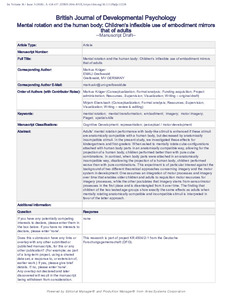| dc.date.accessioned | 2021-08-03T15:35:23Z | |
| dc.date.available | 2021-08-03T15:35:23Z | |
| dc.date.issued | 2018 | |
| dc.identifier | doi:10.17170/kobra-202103253601 | |
| dc.identifier.uri | http://hdl.handle.net/123456789/13069 | |
| dc.description | This is the peer reviewed version of the following article: "Mental rotation and the human body: Children's inflexible use of embodiment mirrors that of adults", which has been published in final form at https://doi.org/10.1111/bjdp.12228. This article may be used for non-commercial purposes in accordance with Wiley Terms and Conditions for Use of Self-Archived Versions. | eng |
| dc.language.iso | eng | eng |
| dc.rights | Urheberrechtlich geschützt | |
| dc.rights.uri | https://rightsstatements.org/page/InC/1.0/ | |
| dc.subject | mental rotation | eng |
| dc.subject | mental transformation | eng |
| dc.subject | embodiment | eng |
| dc.subject | imagery | eng |
| dc.subject | motor imagery | eng |
| dc.subject | Piaget | eng |
| dc.subject | spatial skills | eng |
| dc.subject.ddc | 150 | |
| dc.title | Mental rotation and the human body: Children's inflexible use of embodiment mirrors that of adults | eng |
| dc.type | Aufsatz | |
| dcterms.abstract | Adults’ mental rotation performance with body‐like stimuli is enhanced if these stimuli are anatomically compatible with a human body, but decreased by anatomically incompatible stimuli. In this study, we investigated these effects for kindergartners and first‐graders: When asked to mentally rotate cube configurations attached with human body parts in an anatomically compatible way, allowing for the projection of a human body, children performed better than with pure cube combinations. By contrast, when body parts were attached in an anatomically incompatible way, disallowing the projection of a human body, children performed worse than with pure combinations. This experiment is of specific interest against the background of two different theoretical approaches concerning imagery and the motor system in development: One approach assumes an increasing integration of motor processes and imagery over time that enables older children and adults to requisition motor resources for imagery processes, while the other postulates that imagery stems from early sensorimotor processes in the first place, and is disentangled from it over time. The finding that children of the two age groups tested show exactly the same effects as adults when mentally rotating anatomically compatible and incompatible stimuli is interpreted in favour of the latter approach. | eng |
| dcterms.accessRights | open access | |
| dcterms.creator | Krüger, Markus | |
| dcterms.creator | Ebersbach, Mirjam | |
| dc.relation.doi | doi:10.1111/bjdp.12228 | |
| dc.relation.projectid | Deutsche Forschungsgemeinschaft (DFG). Grant Number: KR 4504/2‐1 | |
| dc.subject.swd | Raumvorstellung | ger |
| dc.subject.swd | Kognitive Entwicklung | ger |
| dc.subject.swd | Kind | ger |
| dc.subject.swd | Motorische Entwicklung | ger |
| dc.subject.swd | Experimentelle Psychologie | ger |
| dc.type.version | acceptedVersion | |
| dcterms.source.identifier | eissn:2044-835X | |
| dcterms.source.identifier | issn:0261-510X | |
| dcterms.source.issue | Issue 3 | |
| dcterms.source.journal | British Journal of Developmental Psychology | eng |
| dcterms.source.pageinfo | 418-437 | |
| dcterms.source.volume | Volume 36 | |
| kup.iskup | false | |

